Applied Mathematics
Vol.3 No.12(2012), Article ID:25341,6 pages DOI:10.4236/am.2012.312251
Some Properties of the Class of Univalent Functions with Negative Coefficients
School of Mathematical Sciences, Faculty of Science and Technology, Universiti Kebangsaan Malaysia, Bangi, Malaysia
Email: eamer_80@yahoo.com, *maslina@ukm.my
Received August 6, 2012; revised October 17, 2012; accepted October 26, 2012
Keywords: Analytic Function; Unit Disc; Coefficient Inequality; Closure Properties; Distortion Bound
ABSTRACT
The main object of this paper is to study some properties of certain subclass of analytic functions with negative coefficients defined by a linear operator in the open unit disc. These properties include the coefficient estimates, closure properties, distortion theorems and integral operators.
1. Introduction
Let  be the class of analytic functions in the open unit disc
be the class of analytic functions in the open unit disc

and  be the subclass of
be the subclass of  consisting of functions of the form
consisting of functions of the form

Let  denote the class of functions
denote the class of functions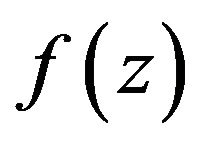 normalized by
normalized by
 (1)
(1)
which are analytic in the open unit disc. In particular,

For two functions 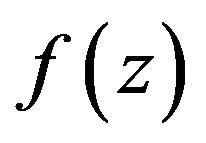 given by (1) and
given by (1) and 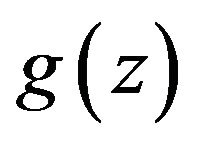 given by
given by

the Hadamard product (or convolution)  is defined, as usual, by
is defined, as usual, by

Let the function 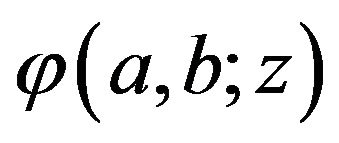 be given by:
be given by:

where ![]() denotes the Pochhammer symbol (or the shifted factorial) defined by:
denotes the Pochhammer symbol (or the shifted factorial) defined by:

Carlson and Shaffer [1] introduced a convolution operator on  involving an incomplete beta function as:
involving an incomplete beta function as:
 (2)
(2)
Our work here motivated by Catas [2], who introduced an operator on  as follows:
as follows:

where

Now, using the Hadamard product (or convolution), the authors (cf. [3,4]) introduced the following linear operator:
Definition 1.1 Let

where

and ![]() is the Pochhammer symbol. We defines a linear operator
is the Pochhammer symbol. We defines a linear operator  by the following Hadamard product:
by the following Hadamard product:
 (3)
(3)
where

and ![]() the Pochhammer symbol .
the Pochhammer symbol .
Special cases of this operator include:
•  see [1].
see [1].
• the Catas drivative operator [2]: 
• the Ruscheweyh derivative operator [5] in the cases:
• 
• the Salagean derivative operator [6]: 
• the generalized Salagean derivative operator introduced by Al-Oboudi [7]: 
• Note that:

Let 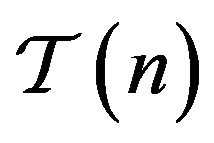 denote the class of functions
denote the class of functions 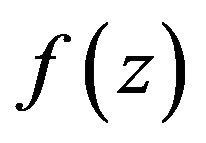 of the form
of the form
 (4)
(4)
which are analytic in the open unit disc.
Following the earlier investigations by [8] and [9], we define  -neighborhood of a function
-neighborhood of a function  by
by

or,

where 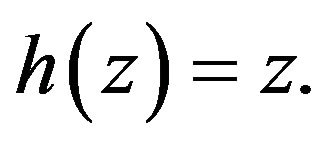
Let  denote the subclass of
denote the subclass of  consisting of functions which satisfy
consisting of functions which satisfy

A function 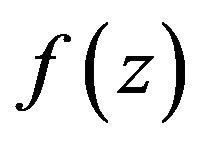 in
in 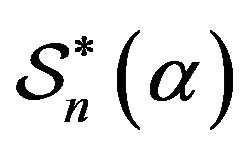 is said to be starlike of order
is said to be starlike of order ![]() in
in .
.
A function  is said to be convex of order
is said to be convex of order ![]() it it satisfies
it it satisfies

We denote by  the subclass of
the subclass of 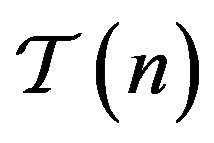 consisting of all such functions [10].
consisting of all such functions [10].
The unification of the classes  and
and 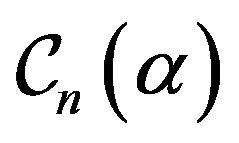 is provided by the class
is provided by the class  of functions
of functions  which also satisfy the following inequality
which also satisfy the following inequality

The class 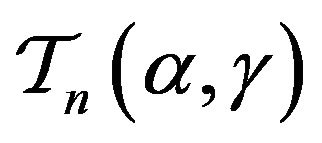 was investigated by Altintas [11].
was investigated by Altintas [11].
Now, by using 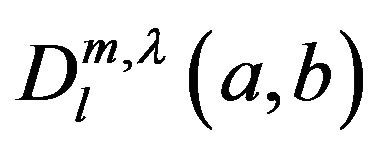 we will define a new class of starlike functions.
we will define a new class of starlike functions.
Definition 1.2 Let

A function  belonging to
belonging to 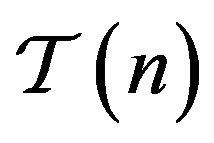 is said to be in the class
is said to be in the class  if and only if
if and only if
 (6)
(6)
Remark 1.3 The class  is a generalization of the following subclasses:
is a generalization of the following subclasses:
i)  and
and
 defined and studied by [12];
defined and studied by [12];
ii)  and
and  studied by [13] and [14];
studied by [13] and [14];
iii)  studied by [15];
studied by [15];
iv)  studied by [16].
studied by [16].
Now, we shall use the same method by [17] to establish certain coefficient estimates relating to the new introduced class.
2. Coefficient Estimates
Theorem 2.1 Let the function  be defined by (1). Then
be defined by (1). Then  belongs to the class
belongs to the class  if and only if
if and only if
 (7)
(7)
where
 (8)
(8)
The result is sharp and the extremal functions are
 (9)
(9)
Proof: Assume that the inequality (7) holds and let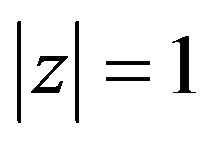 . Then we have
. Then we have
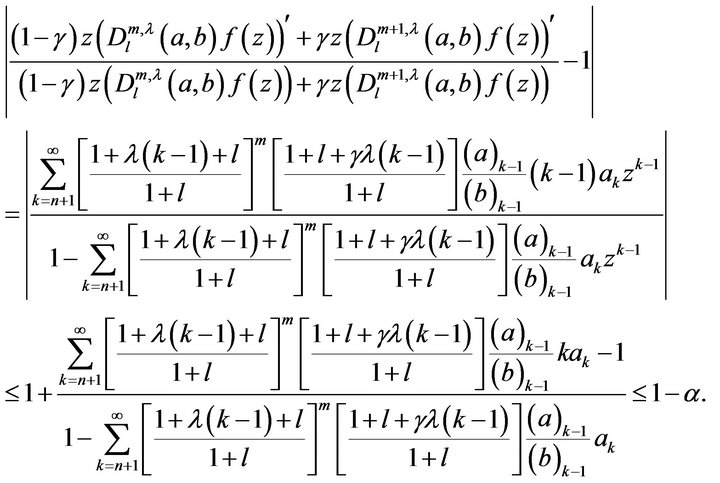
Consequently, by the maximum modulus theorem one obtains

Conversely,suppose that
 .
.
Then from (6) we find that

Choose values of  on the real axis such that
on the real axis such that

is real. Letting 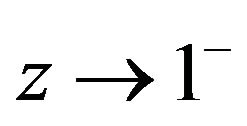 through real values, we obtain
through real values, we obtain

or, equivalently

which gives (7).
Remark 2.2 In the special case 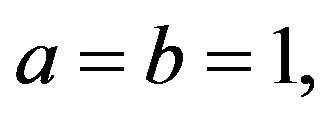 Theorem 2.1 yields a result given earlier by [17].
Theorem 2.1 yields a result given earlier by [17].
Remark 2.3 In the special case 
 Theorem 2.2 yields a result given earlier by [6].
Theorem 2.2 yields a result given earlier by [6].
Theorem 2.4 Let the function  defined by (3) be in the class
defined by (3) be in the class . Then
. Then
 (10)
(10)
and
 (11)
(11)
The equality in (10) and (11) is attained for the function  given by (9).
given by (9).
Proof: By using Theorem 2.2, we find from (6) that

which immediately yields the first assertion (10) of Theorem 2.3.
On the other hand, taking into account the inequality (6), we also have

that is

which, in view of the coefficient inequality (10), can be put in the form
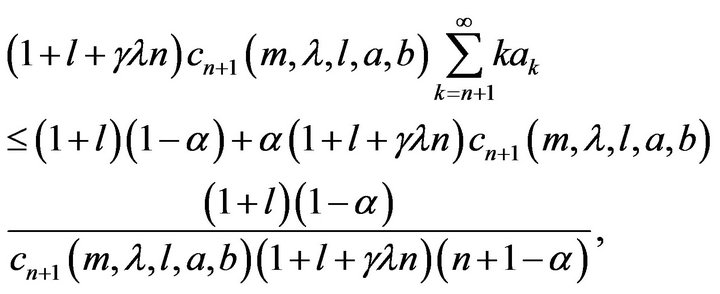
and this completes the proof of (11).
3. Closure Theorem
Theorem 3.1 Let the function  be defined by
be defined by

for 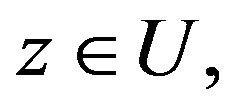 be in the class
be in the class  then the function
then the function  defined by
defined by

also belongs to the class , where
, where

Proof: Since  it follows from Theorem 2.1, that
it follows from Theorem 2.1, that

Therefore,

Hence by Theorem 2.1,  also.
also.
Morever, we shall use the same method by [17] to prove the distrotion Theorems.
4. Distortion Theorems
Theorem 4.1 Let the function  defined by (1) be in the class
defined by (1) be in the class . Then we have
. Then we have
 (12)
(12)
and
 (13)
(13)
for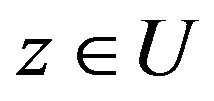 , where
, where  and
and  is given by (8).
is given by (8).
The equalities in (12) and (13) are attained for the function  given by
given by
 (14)
(14)
Proof: Note that  if and only if
if and only if
 , where
, where

By Theorem 2.2, we know that

that is
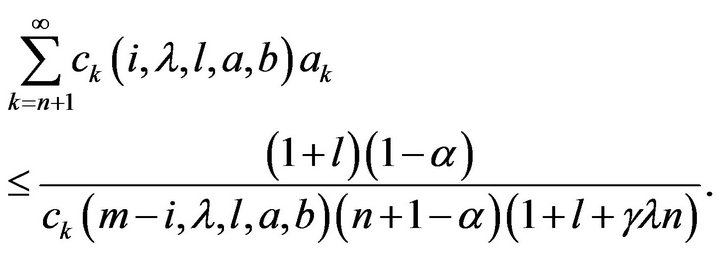
The assertions of (12) and (13) of Theorem 4.1 follow immediately. Finally, we note that the equalities (12) and (13) are attained for the function  defined by
defined by

This completes the proof of Theorem 4.1.
Remark 4.2 In the special case  Theorem 4.1 yields a result given earlier by [17].
Theorem 4.1 yields a result given earlier by [17].
Corollary 4.3 Let the function  defined by (1) be in the class
defined by (1) be in the class . Then we have
. Then we have
 (15)
(15)
and
 (16)
(16)
for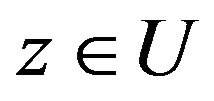 . The equalities in (15) and (16) are attained for the function
. The equalities in (15) and (16) are attained for the function  given in (14).
given in (14).
Corollary 4.4 Let the function  defined by (1) be in the class
defined by (1) be in the class . Then we have
. Then we have
 (17)
(17)
and
 (18)
(18)
for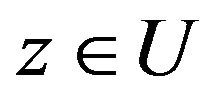 . The equalities in (17) and (18) are attained for the function
. The equalities in (17) and (18) are attained for the function  given in (14).
given in (14).
Corollary 4.5 Let the function  defined by (3) be in the class
defined by (3) be in the class . Then the unit disc is mapped onto a domain that contains the disc
. Then the unit disc is mapped onto a domain that contains the disc

The result is sharp with the extremal function  given in (14).
given in (14).
5. Integral Operators
Theorem 5.1 Let the function 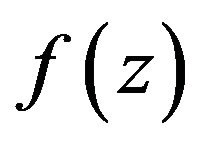 defined by (1) be in the class
defined by (1) be in the class  and let
and let ![]() be a real number such that
be a real number such that 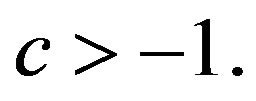 Then
Then  defined by
defined by

also belongs to the class 
Proof: From the representation of 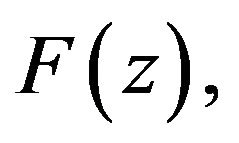 it is obtained that
it is obtained that

where
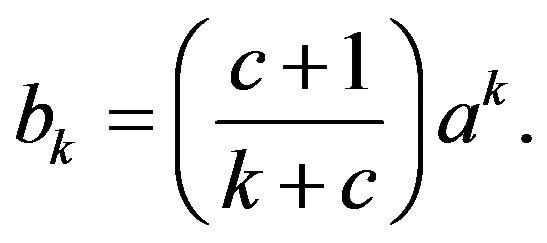
Therefore
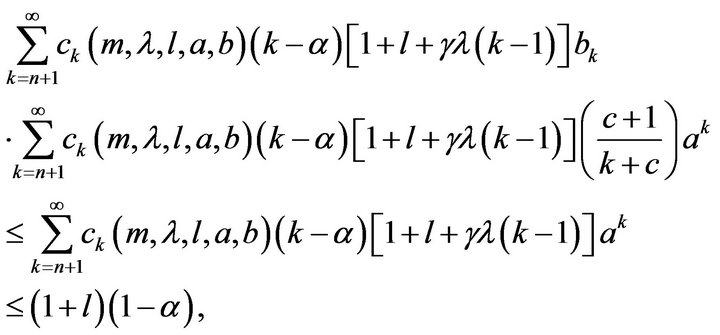
since  belongs to
belongs to  so by virtue of Theorem 2.1,
so by virtue of Theorem 2.1, 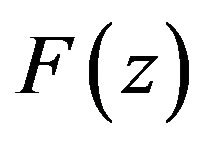 is also element of
is also element of

6. Acknowledgements
The work presented here was partially supported by LRGS/TD/2011/UKM/ICT/03/02.
REFERENCES
- B. C. Carlson and D. B. Shaffer, “Starlike and Prestarlike Hypergeometric Functions,” SIAM Journal on Mathematical Analysis, Vol. 15, No. 4, 1984, pp. 737-745. doi:10.1137/0515057
- A. Catas, “On a Certain Differential Sandwich Theorem Associated with a New Generalized Derivative Operator,” General Mathematics, Vol. 17, No. 4, 2009, pp. 83-95.
- A. A. Amer and M. Darus, “A Distortion Theorem for a Certain Class of Bazilevic Function,” International Journal of Mathematical Analysis, Vol. 6, No. 12, 2012, pp. 591-597.
- A. A. Amer and M. Darus, “On a Property of a Subclass of Bazilevic Functions,” Missouri Journal of Mathematical Sciences, In Press.
- St. Ruscheweyh, “New Criteria for Univalent Functions,” Proceedings of the American Mathematical Society, Vol. 49, No. 1, 1975, pp. 109-115.
- G. S. Salagean, “Subclasses of Univalent Functions,” Lecture Notes in Mathematics, Vol. 1013, 1983, pp. 362- 372. doi:10.1007/BFb0066543
- F. M. Al-Oboudi, “On Univalent Functions Defined by a Generalized Salagean Operator,” International Journal of Mathematics and Mathematical Sciences, Vol. 2004, No. 27, 2004, pp. 1429-1436. doi:10.1155/S0161171204108090
- A. W. Goodman, “Univalent Functions and Nonanalytic Curves,” Proceedings of the American Mathematical Society, Vol. 8, No. 3, 1957, pp. 598-601. doi:10.1090/S0002-9939-1957-0086879-9
- St. Ruscheweyh, “Neighborhoods of Univalent Functions,” Proceedings of the American Mathematical Society, Vol. 81, No. 4, 1981, pp. 521-527. doi:10.1090/S0002-9939-1981-0601721-6
- O. Alintas, H. Irmak and H. M. Srivastava, “Fractional Calculus and Certain Starlike Functions with Negative Coefficietns,” Computers & Mathematics with Applications, Vol. 30, No. 2, 1995, pp. 9-15. doi:10.1016/0898-1221(95)00073-8
- O. Alintas, “On a Subclass of Certain Starlike Functions with Negative Coefficients,” Journal of the Mathematical Society of Japan, Vol. 36, 1991, pp. 489-495.
- H. Silverman, “Univalent Functions with Negative Coefficients,” Proceedings of the American Mathematical Society, Vol. 51, No. 1, 1975, pp. 109-116. doi:10.1090/S0002-9939-1975-0369678-0
- S. K. Chatterjea, “On Starlike Functions,” Journal of Pure Mathematics, Vol. 1, 1981, pp. 23-26.
- H. M. Srivastava, S. Owa and S. K. Chatterjea, “A Note on Certain Classes of Starlike Functions,” Rendiconti del Seminario Matematico della Università di Padova, Vol. 77, 1987, pp.115-124.
- M. D. Hur and G. H. Oh, “On Certain Class of Analytic Functions with Negative Coefficients,” Pusan Kyongnam Mathematical Journal, Vol. 5, No. 1, 1989, pp. 69-80.
- M. Kamali, “Neighborhoods of a New Class of p-Valently Functions with Negative Coefficients,” Mathematical Inequalities & Applications, Vol. 9, No. 4, 2006, pp. 661- 670. doi:10.7153/mia-09-59
- A. Catas, “Neighborhoods of a Certain Class of Analytic Functions with Negative Coefficients,” Banach Journal of Mathematical Analysis, Vol. 3, No. 1, 2009, pp. 111- 121.
NOTES
*Corresponding author.

